¶ Battle
Once finished the maneuver, the active player may attack with one's  army /
army /  corps the units or structures of another player. In this case, the active player is the attacker, and the attacked player is the defender.
corps the units or structures of another player. In this case, the active player is the attacker, and the attacked player is the defender.
During the battle the attacker army attacks the defender army. The defender army counterattacks if the attacker is located within the  attack range of the defender. If the defender army is undepleted, it can perform the reaction maneuver in order to improve its tactic position, or to bring the enemy into its attack range. The defender also uses the reaction maneuver to engage more units as a part of one's
attack range of the defender. If the defender army is undepleted, it can perform the reaction maneuver in order to improve its tactic position, or to bring the enemy into its attack range. The defender also uses the reaction maneuver to engage more units as a part of one's  corps to enhance the defense.
corps to enhance the defense.
First, each fighter calculates the attack force of their army and prepares the  attack cubes and/or
attack cubes and/or  defense cubes. Each fighter puts the prepared cubes in the battle bag. Then the attacker mixes and draws the defined number of cubes without looking at the bag. The losses of each fighter are the number of enemy cubes drawn from the bag.
defense cubes. Each fighter puts the prepared cubes in the battle bag. Then the attacker mixes and draws the defined number of cubes without looking at the bag. The losses of each fighter are the number of enemy cubes drawn from the bag.
Let's look at the battle step by step:
¶ 1. Bag preparation 
Prepare as many attack / defense cubes as the sum of the strength value and the strength bonus of your  army involved in the battle.
army involved in the battle.
Army strength:
- +n
 strength value for every unit in this army
strength value for every unit in this army
- +n
 for the strength bonus of one of the units of this army against one of the units of an enemy army or enemy structures.
for the strength bonus of one of the units of this army against one of the units of an enemy army or enemy structures.
Army strength bonus:
- +1
 for every
for every  relic of the army
relic of the army - +1
 for the defender army located in the mountains
for the defender army located in the mountains - +1
 for the defender army located in the city
for the defender army located in the city - +1
 for the defender army located behind the allied wall / palisade
for the defender army located behind the allied wall / palisade - +1
 for the army located in the castle
for the army located in the castle - -1
 for every depletion cube of this army, except the first one
for every depletion cube of this army, except the first one - ±n
 for your and enemy's strength bonus modifiers
for your and enemy's strength bonus modifiers
Additionally, you may add any amount of action cubes and experience cubes.
If there are a couple of armies involved in the battle as a single  corps, then prepare as many attack / defense cubes, as the sum of the strength value and strength bonus of your corps.
corps, then prepare as many attack / defense cubes, as the sum of the strength value and strength bonus of your corps.
Corps strength:
- +n
 for strength value of each army of this corps
for strength value of each army of this corps
- +n
 for the strength bonus of one chosen army of this corps.
for the strength bonus of one chosen army of this corps.
Corps strength bonus is taken into account if the conditions of the corresponding technologies are met.
If the attack range of the units lets you attack the enemy, those units are active in the battle. Take  attack cubes for active units, and
attack cubes for active units, and  defense cubes - for the inactive ones.
defense cubes - for the inactive ones.
Peasants are always inactive units - you can take only  for them.
for them.
Both sides may opt out from adding defense  to the bag.
to the bag.
The attack range of  melee units does not let you attack the enemy on the adjacent water hex. For example, swordsmen cannot attack the vessels from the shore.
melee units does not let you attack the enemy on the adjacent water hex. For example, swordsmen cannot attack the vessels from the shore.
Once every fighter has prepared one's cubes, the attacker puts all the cubes to the battle bag  .
.
¶ 2*. Conversion 
Conversion is an action that results in one of enemy units may switch to your side.
This stage occurs only if one of the fighters has the conversion action available. If both fighters have the conversion available, the defender performs it first.
You have to pass the check 
 2 for the successful conversion. For that do the following:
2 for the successful conversion. For that do the following:
- Calculate the number of cubes you should draw from the battle bag.
Reduce the check complexity for every your army carries and if the enemy army is located in your
your army carries and if the enemy army is located in your  religious community.
religious community.
Increase the check complexity for every the enemy army carries and if the enemy army is located in their
the enemy army carries and if the enemy army is located in their  religious community.
religious community.
- Pass the check. If it is successful (none of enemy
 drawn) - put the drawn cubes of your color on your card of
drawn) - put the drawn cubes of your color on your card of  . This way you have gained experience.
. This way you have gained experience.
Remove one enemy unit of your choice from the map, and place your unit of the same type on the adjacent hex, and put a depletion cube on it.
depletion cube on it.
After that, if there are enemy units left, the battle continues. The converted unit does not take part in this battle. - If you failed the check, return the drawn cubes back to the bag and proceed to the next battle stage.
The features of technologies, governments and nations may allow more than one conversion action. In this case, perform the algorithm mentioned above a couple of times.
Repeat this algorithm as many times, as conversion action is featured on your game components ( ,
,  ,
,  ).
).
¶ 3. Clash (drawing from the bag)
The attacker mixes the cubes in the battle bag thoroughly. They randomly draw from the bag any number of cubes from one up to the value of courage of their (attacker) army.
If the attacker decides to draw fewer cubes than the value of defender army courage, the defender may draw additional cubes. In this case, the number of final draw is limited to the value of defender army courage.
¶ 4. Losses
The cubes drawn from the bag symbolize the success of each sides and show the extent of the military losses.
You deal 1 damage to the enemy for each of your attack cubes drawn. In order to destroy the enemy object, you need to deal as much damage as the number of  hit points this object has. For instance, usually you have to deal 1 damage to destroy 1 unit, 3 damage to destroy a city and 4 damage - to destroy a castle.
hit points this object has. For instance, usually you have to deal 1 damage to destroy 1 unit, 3 damage to destroy a city and 4 damage - to destroy a castle.
The enemy deals the damage to your army as well. Lost units are removed from the map for both fighters at the same time.
If it is the combined arms army your enemy has, then it is you who decide what units are removed. If it is fortified, or it is located on a hex with any  structures, keep the destruction priority of enemy objects:
structures, keep the destruction priority of enemy objects:
- First of all, destroy the wall / palisade in front of the enemy army
- Destroy all enemy units
- Buildings
- Wonder
- Castle
- City
If it is the enemy  corps, you also decide what objects you remove, but keep the destruction priority on every affected hex.
corps, you also decide what objects you remove, but keep the destruction priority on every affected hex.
At the same time, the decision about your losses is made by the enemy.
If the damage you deal to the enemy structure is not enough to destroy it (the structures has >  1), put the corresponding number of
1), put the corresponding number of  black cubes on it. This symbolizes the
black cubes on it. This symbolizes the  damage it took. Galleys and other units with >
damage it took. Galleys and other units with >  1 ignore all the damage that is unable to destroy them, -
1 ignore all the damage that is unable to destroy them, -  black cubes are not placed on them.
black cubes are not placed on them.
In order to destroy the  damaged structure, deal it as much damage, so the total number of damage dealt equals or exceeds the number of its
damaged structure, deal it as much damage, so the total number of damage dealt equals or exceeds the number of its  hit points.
hit points.
If there are as many  black cubes on the structures as the number of hit points it has, it is destroyed instantly, without the need to to deal any damage.
black cubes on the structures as the number of hit points it has, it is destroyed instantly, without the need to to deal any damage.
¶ 5*. Recovery 
Recovery is the action that results in canceling 1 damage you took, so that one of your units may be returned back to the map.
This stage occurs only if one of the fighters has the recovery action available. If both fighters have the recovery available, the defender performs it first.
You have to pass the check 
 2 for the successful recovery. For that do the following:
2 for the successful recovery. For that do the following:
- Calculate the number of cubes that should be drawn from the battle bag. Reduce the check complexity for every
 your army carries.
your army carries.
- Pass the check. If it is the success (none of enemy
 drawn) - put the drawn cubes of your color on your
drawn) - put the drawn cubes of your color on your  . This way you have gained experience.
. This way you have gained experience.
Take back one of your lost units of your choice, place it on the adjacent hex and deplete it.
The recovered unit does not affect the determination of the winner of the battle. - If you failed the check, return the drawn cubes back to the bag.
Repeat this algorithm as many times, as recovery action is featured on your game components ( ,
,  ,
,  ).
).
¶ 6. End of battle
You win a battle (get the victory in battle), if you destroy all the enemy units and structures involved in this combat.
Therefore, there are 3 scenarios possible:
- The attacker won and the defender lost.
- The defender won, the attacker lost.
- There is no winner. In this case, both sides did not lose the battle.
During this stage you can get  experience cubes, if you meet the requirements of your
experience cubes, if you meet the requirements of your  government or
government or  technologies.
technologies.
The army of Laura of 3 spearmen units attacks the army of Alex of 2 cavalrymen units.
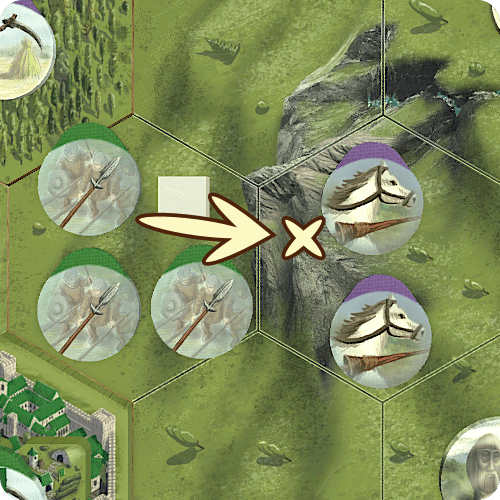
Laura is the attacker, she prepares her cubes:
+3 for the strength values of her units
for the strength values of her units+3
 for the strength bonus of spearmen against
for the strength bonus of spearmen against  cavalry
cavalry6
 attack cubes total.
attack cubes total.
Alex is the defender, he prepares his attack cubes as well:
+2 for the strength values of his units
for the strength values of his units+1
 for the strength bonus of cavalrymen against
for the strength bonus of cavalrymen against  infantry
infantry+1
 for the strength bonus of his army for being in the mountains
for the strength bonus of his army for being in the mountains4
 attack cubes total.
attack cubes total.
Laura puts all 10 cubes into the battle bag and mixes them thoroughly. Laura's army has a courage value of 3, so she can draw between one and three cubes from the bag. She drew three cubes at once: two green and one purple. So the battle losses are -2 cavalrymen for Alex (for 2 cubes of Laura), -1 spearmen for Laura (for 1 cubes of Alex).
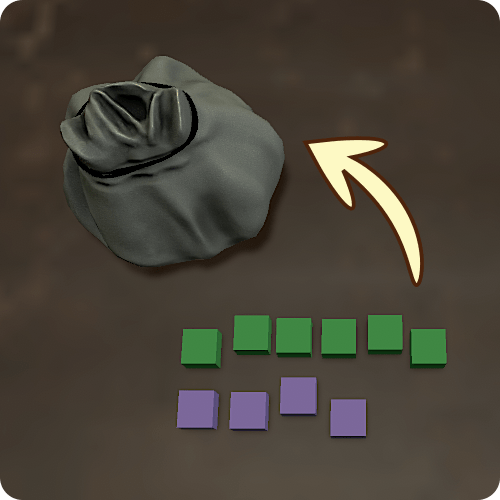
Therefore, Laura is the winner of this battle, as her army destroyed all the units of Alex. This battle was quite favorable for Laura, as spearmen are cheaper and weaker than cavalrymen, but at the same time they are effective against cavalrymen. In the game, spearmen are counter units against cavalrymen (and other mounted units).
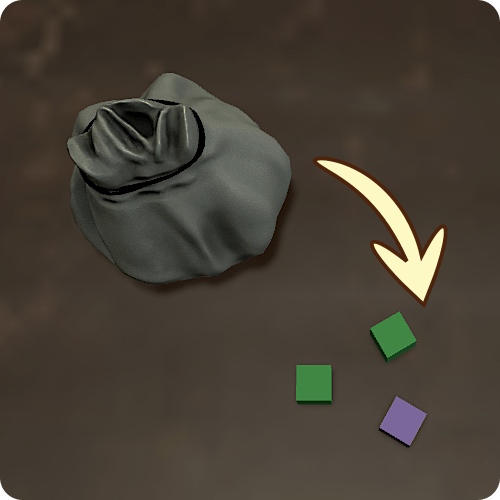
Army А of Alex attacks the army B of Mike. Army B consists of melee units, therefore, the enemy army is out of its attack range. Mike would want to perform the reaction maneuver and move closer to the enemy army, but it is already depleted. He would have moved the army C as the reinforcement, but it is impossible as both of his armies would form the  corps, and that exceeds his corps size limit (Mike does not have any castles built yet).
corps, and that exceeds his corps size limit (Mike does not have any castles built yet).

Alex is the attacker, he prepares his cubes:
+3 for strength values of his active units (archers)
for strength values of his active units (archers)+1
 for the strength bonus of archers
against
for the strength bonus of archers
against  infantry
infantry4 attack
 total. Alex decides not to add 1 defense cube for his swordsmen unit.
total. Alex decides not to add 1 defense cube for his swordsmen unit.
Mike is the defender, he prepares his cubes:
+3 for strength values of his inactive units (they cannot reach the enemy)
for strength values of his inactive units (they cannot reach the enemy)+2
 for the strength bonus of inactive swordsmen against
for the strength bonus of inactive swordsmen against  infantry
infantry-1
 for the strength bonus of this depleted army with two depletion cubes
for the strength bonus of this depleted army with two depletion cubes+2
 experience cube Mike adds from his Democracy card
experience cube Mike adds from his Democracy card2 attack
 and 4 defense
and 4 defense  total.
total.
Alex mixes those 10 cubes in the bag and draws 3 cubes. They are 2 purple and 1 neutral.
Therefore, Alex causes losses to Mike, removing his 2 swordsmen units.
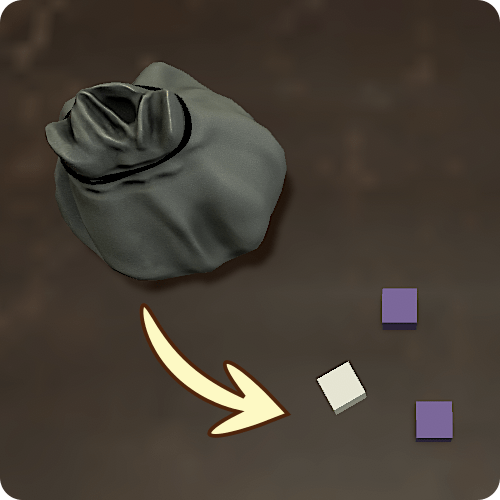
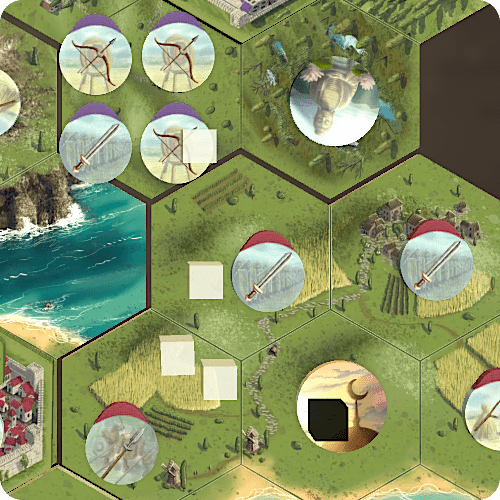
Since Mike has a DEMOCRACY government, he attempts to recover his losses by performing a recovery action. He draws 2 cubes from the bag: 1 of his own cubes and 1 neutral cube.
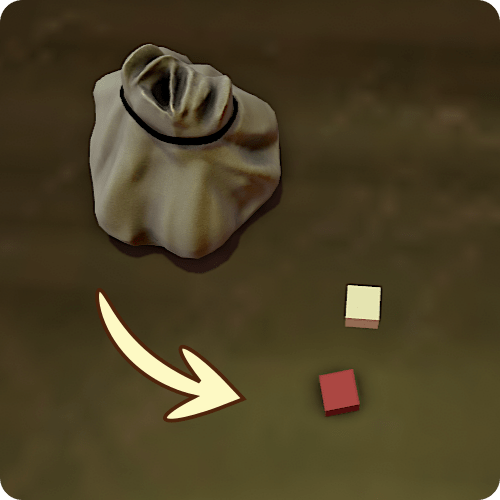
Therefore, he passes the check and places his lost swordsmen unit on the adjacent hex. He puts his just drawn cube on his DEMOCRACY card, getting experience, and discards the neutral cube drawn.

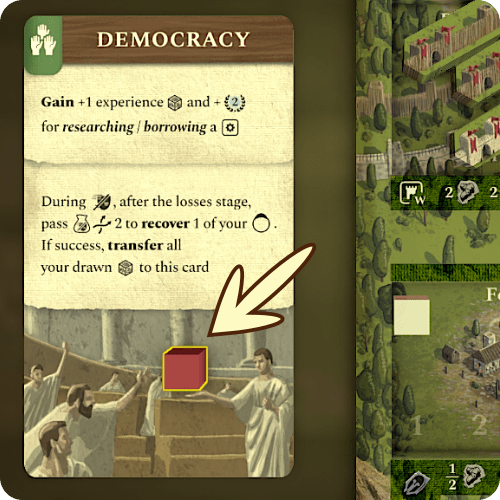
¶ Siege
The battle that involves attacking the fortification, is called the siege.
During a siege, the defender of a fortification ignores the strength bonuses of  melee and
melee and  ranged units. Thus, the attacker cannot apply these bonuses against the fortification's garrison during the bag preparation phase.
ranged units. Thus, the attacker cannot apply these bonuses against the fortification's garrison during the bag preparation phase.
If you lose your city, castle or any building, put it back on your player mat. It's up to you to decide which building it was by placing it in a certain area of your player mat. You can reconstruct this building during the current round if you wish.
The defender army located on the hex with the wall or the palisade is considered the garrison if the wall is on the attack line.
Laura performs a maneuver with her corps, splitting army B along the way to create two separate armies, each containing projectile attack units. Once the movement is completed, Laura declares an attack on Alex's city with her armies A, B, and C.
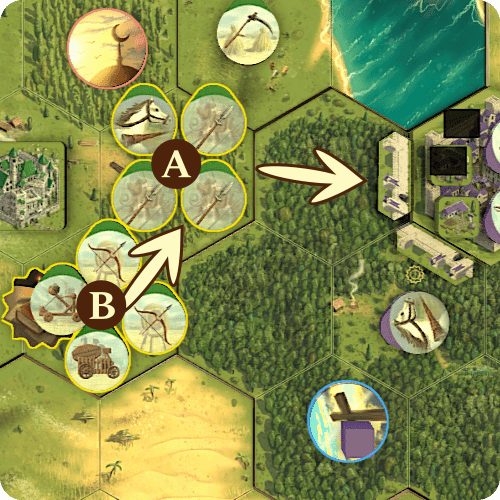

In response, Alex performs a reaction maneuver and counterattacks army B with his cavalrymen. As a result, the defending forces consist of corps D and E.
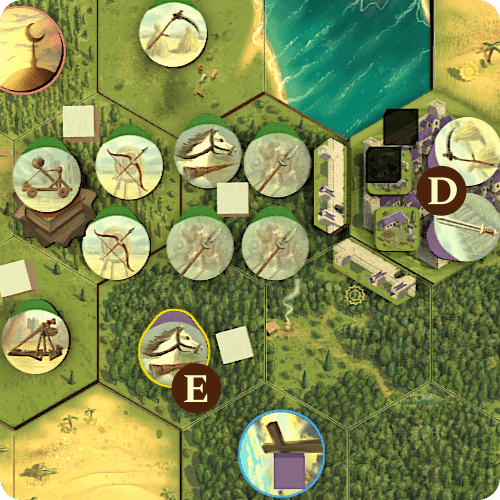
Laura prepares her cubes:
+7 for the strength of army A (+4 for units, +3 strength bonus of spearmen against cavalry)
for the strength of army A (+4 for units, +3 strength bonus of spearmen against cavalry)+6
 for the strength of army B (+3 for units, +1 for relic, +2 bonus of the catapult against structures)
for the strength of army B (+3 for units, +1 for relic, +2 bonus of the catapult against structures)+5
 for the strength of army C (+1 for the trebuchet, +4 bonus of trebuchet against structures)
for the strength of army C (+1 for the trebuchet, +4 bonus of trebuchet against structures)18 attack
 total.
total.
Alex prepares his cubes:
+5 and +1
and +1  for the strength of garrison D (+1 for swordsman, +2 bonus of swordsman against infantry, +1 for defending the city, +1 for defending the wall, +1 defense cube for peasant)
for the strength of garrison D (+1 for swordsman, +2 bonus of swordsman against infantry, +1 for defending the city, +1 for defending the wall, +1 defense cube for peasant)+4
 for the strength of army E (+1 for unit, +3 bonus of cavalrymen against archers)
for the strength of army E (+1 for unit, +3 bonus of cavalrymen against archers)+2
 for the added 2 action cubes
for the added 2 action cubes11 attack
 and 1 defense
and 1 defense  total.
total.
Laura uses her FABIAN TACTIC technology, discarding 4 green and 4 purple cubes. The remaining cubes are added to the bag.

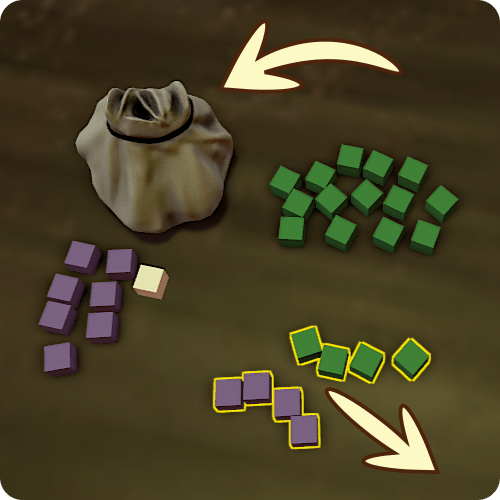
Alex has THEOCRACY, so he performs a conversion action. Since army A of Laura is located in a province with CHRISTIANITY (Alex's state religion), the complexity of the conversion is reduced. Even though army B possesses a relic, it does not increase the complexity of conversion, as Alex opts to convert a unit from army A instead.

Alex attempts to pass the conversion check with complexity of 1, drawing 1 random cube from the bag. He successfully draws his own cube, placing it on his THEOCRACY card, thereby gaining an experience cube and converting one of Laura's units. He removes 1 green spearman, replaces it with his own spearman on an adjacent hex, and places a depletion cube on it.
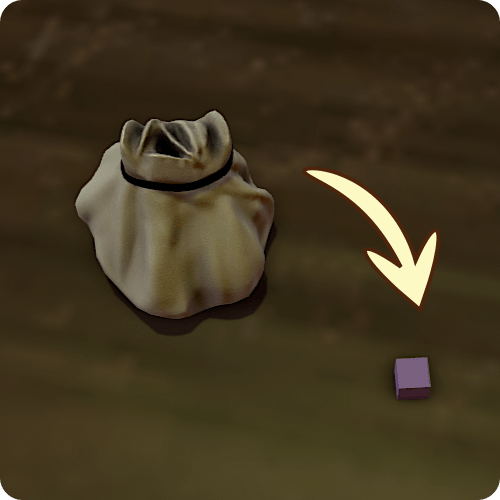

Although Laura has 7 active units, both armies B and C include projectile attack units, granting each of them +1 courage. Additionally, the SIEGE TOWER technology provides +1 courage. As a result, Laura can draw a total of 10 cubes.
So she draws 10 random cubes: 6 green, 3 purple and 1 neutral.
Laura does not quite like the result, so she uses her TRAINED ARMY technology - puts 2 purple cubes back to the bag and redraws the cubes. She drew 1 green and 1 purple instead.
The final result after all redraws is 7 green, 2 purple and 1 neutral cubes.
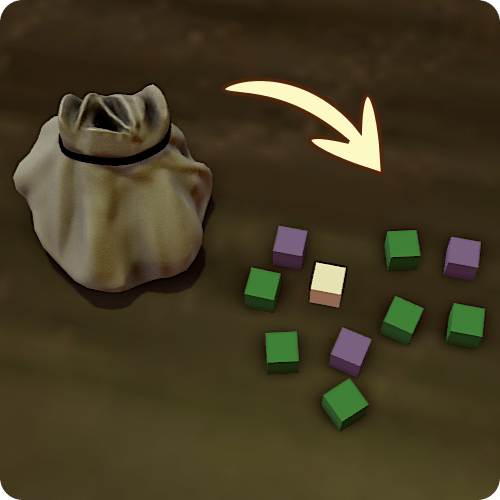
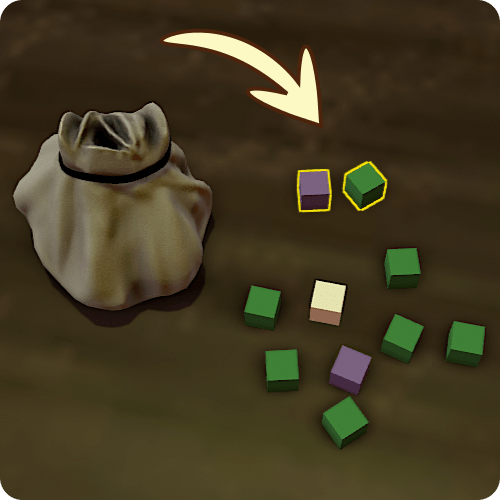
While dealing damage, Laura removes 1 building with 0 hit points, as it already has a black cube on it. She deals a total of 7 damage, eliminating 1 cavalry unit, 1 swordsman unit, 1 peasant unit, 1 building, and the city with 2 hit points, while also placing 1 black cube on the wall. Laura ignores the destruction priority and bypasses the wall due to her SIEGE TOWER technology. In response, Alex removes 1 trebuchet and 1 catapult from Laura’s forces.
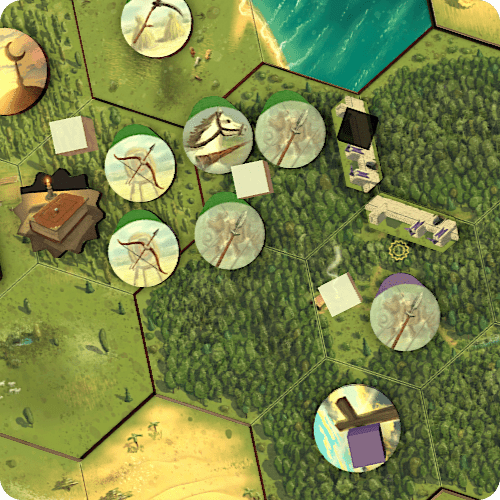
Without the SIEGE TOWER technology, Laura wouldn’t have been able to destroy the city due to insufficient damage. Since the city is destroyed, Larisa earns the MIGHTINESS achievement. Meanwhile, Alex returns 1 action cube to the supply on his mat and no longer pays additional consumption for the destroyed city.